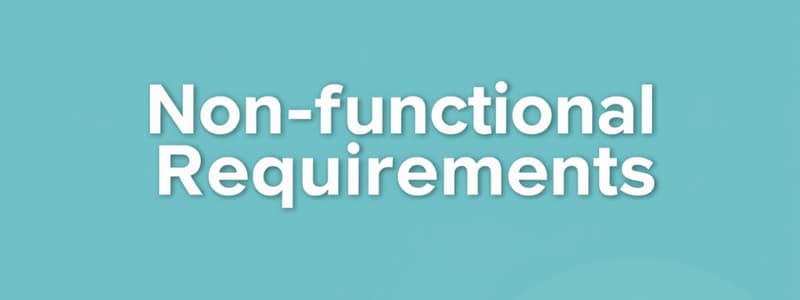Podcast
Questions and Answers
Non-functional requirements specify how a product must behave, such as execution speed and __________.
Non-functional requirements specify how a product must behave, such as execution speed and __________.
reliability
__________ requirements arise from factors external to the system and its development process.
__________ requirements arise from factors external to the system and its development process.
External
The Mentcare system must be available to all clinics during __________ hours.
The Mentcare system must be available to all clinics during __________ hours.
normal working
A __________ is a general intention of the user, like ease of use, that guides the development process.
A __________ is a general intention of the user, like ease of use, that guides the development process.
Medical staff shall be able to use all system functions after __________ hours of training.
Medical staff shall be able to use all system functions after __________ hours of training.
Flashcards are hidden until you start studying
Study Notes
Non-Functional Requirements
- Classified into product, organizational, and external requirements.
- Product requirements specify how a product should perform (e.g., execution speed, reliability).
- Organizational requirements stem from organizational policies (e.g., process standards, implementation needs).
- External requirements are derived from external factors (e.g., interoperability, legislation).
Examples in Mentcare System
- Product requirement: Availability during working hours with a maximum downtime of five seconds daily.
- Organizational requirement: User authentication through health authority identity cards.
- External requirement: Compliance with patient privacy laws outlined in HStan-03-2006-priv.
Goals and Requirements
- Non-functional requirements can be hard to articulate and verify.
- Goals express users' general intentions (e.g., ease of use).
- Verifiable non-functional requirements can be objectively measured and tested.
- Goals guide developers on user needs and system intentions.
Usability Requirements
- System must be user-friendly for medical staff, aiming to reduce errors.
- Training requirement: medical staff should require no more than four hours of training to operate all system functions.
- Post-training, error rate for experienced users should not exceed two errors per hour.
Requirements Engineering Processes
- Varies based on application domain, stakeholders, and organizational practices.
- Core activities: requirements elicitation, analysis, validation, and management.
- Requires iterative interaction among these activities throughout the development cycle.
Requirements Elicitation and Analysis
- Involves collaboration between technical staff and stakeholders to identify needs.
- Stakeholders can include end-users, managers, and domain experts.
Requirements Discovery
- Gathering details about user needs and system functionalities by interacting with stakeholders.
- Key stages: discovery, classification, organization, prioritization, and negotiation.
Challenges in Requirements Elicitation
- Stakeholders may have unclear or conflicting requirements.
- Requirements can evolve during analysis.
- New stakeholders might emerge, affecting the requirements landscape.
Interview Techniques
- Both closed (pre-determined questions) and open-ended interviews are utilized for gathering information.
- Effective interviewing requires open-mindedness and the willingness to actively listen and suggest ideas.
Scenarios and User Stories
- Scenarios describe practical situations reflecting system use, aiding in stakeholder understanding and feedback.
- Properly structured scenarios should detail the starting situation, flow of events, potential issues, and final state.
Requirements Versus Design
- Requirements describe what the system should accomplish, while design details how to achieve it.
- Real-life constraints and external factors can blur the lines between requirements and design due to regulatory and inter-operational dependencies.
Natural Language Specification
- Requirements are drafted in natural language, supplemented by diagrams for clarity.
- This approach promotes user understanding but may introduce ambiguity.
Guidelines for Writing Requirements
- Maintain standard formats and consistent language use.
- Utilize "shall" for mandatory and "should" for desirable requirements.
- Avoid jargon and include rationale for each requirement.
Problems with Natural Language
- Clarity can be compromised, leading to confusion between functional and non-functional requirements.
- Complex specifications may inadvertently combine multiple requirements.
Structured Specifications
- An alternative to natural language that limits the author's flexibility, fostering consistency and rigidity in certain requirements domains.
Software Requirements Document
- Serves as the official record outlining system development needs.
- Should detail user requirements without prescribing how those requirements should be met.
- Variability in documentation detail is expected based on the system type and development approach.
Studying That Suits You
Use AI to generate personalized quizzes and flashcards to suit your learning preferences.




